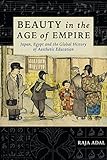Beauty in the Age of Empire : Japan, Egypt, and the Global History of Aesthetic Education / Raja Adal.
Material type: TextSeries: Columbia Studies in International and Global HistoryPublisher: New York, NY : Columbia University Press, [2019]Copyright date: ©2019Description: 1 online resource : 43 b&w illustrationsContent type:
TextSeries: Columbia Studies in International and Global HistoryPublisher: New York, NY : Columbia University Press, [2019]Copyright date: ©2019Description: 1 online resource : 43 b&w illustrationsContent type: - 9780231191166
- 9780231549288
- 700.71 23
- online - DeGruyter
- Issued also in print.
| Item type | Current library | Call number | URL | Status | Notes | Barcode | |
|---|---|---|---|---|---|---|---|
 eBook
eBook
|
Biblioteca "Angelicum" Pont. Univ. S.Tommaso d'Aquino Nuvola online | online - DeGruyter (Browse shelf(Opens below)) | Online access | Not for loan (Accesso limitato) | Accesso per gli utenti autorizzati / Access for authorized users | (dgr)9780231549288 |
Frontmatter -- Contents -- Illustrations -- Note on Names -- Acknowledgments -- Introduction -- 1. The Modern School as a Global Archive -- I. Music, Calligraphy, and the Education of the Inner Self -- Interlude. How Culture Travels: A Global History of the Piano -- 2. Music Education and the Uses of Aesthetics -- 3. Writing Education and the Location of Aesthetics -- II. From Mimesis to Art -- Interlude. Mimesis and Seduction in National Anthems -- 4. The Mimetic Moment -- 5. The End of Global Mimesis -- 6. The End of Representational Mimesis -- Conclusion -- Notes -- Works Cited -- Index
restricted access online access with authorization star
http://purl.org/coar/access_right/c_16ec
When modern primary schools were first founded in Japan and Egypt in the 1870s, they did not teach art. By the middle of the twentieth century, art education was a permanent part of Japanese and Egyptian primary schooling. Both countries taught music and drawing, and wartime Japan also taught calligraphy. Why did art education become a core feature of schooling in societies as distant as Japan and Egypt, and how is aesthetics entangled with nationalism, colonialism, and empire?Beauty in the Age of Empire is a global history of aesthetic education focused on how Western practices were adopted, transformed, and repurposed in Egypt and Japan. Raja Adal uncovers the emergence of aesthetic education in modern schools and its role in making a broad spectrum of ideologies from fascism to humanism attractive. With aesthetics, educators sought to enchant children with sounds and sights, using their ears and eyes to make ideologies into objects of desire. Spanning multiple languages and continents, and engaging with the histories of nationalism, art, education, and transnational exchanges, Beauty in the Age of Empire offers a strikingly original account of the rise of aesthetics in modern schools and the modern world. It shows that while aesthetics is important to all societies, it was all the more important for those on the receiving end of Western expansion, which could not claim to be wealthier or more powerful than Western empires, only more beautiful.
Issued also in print.
Mode of access: Internet via World Wide Web.
In English.
Description based on online resource; title from PDF title page (publisher's Web site, viewed 02. Mrz 2022)


